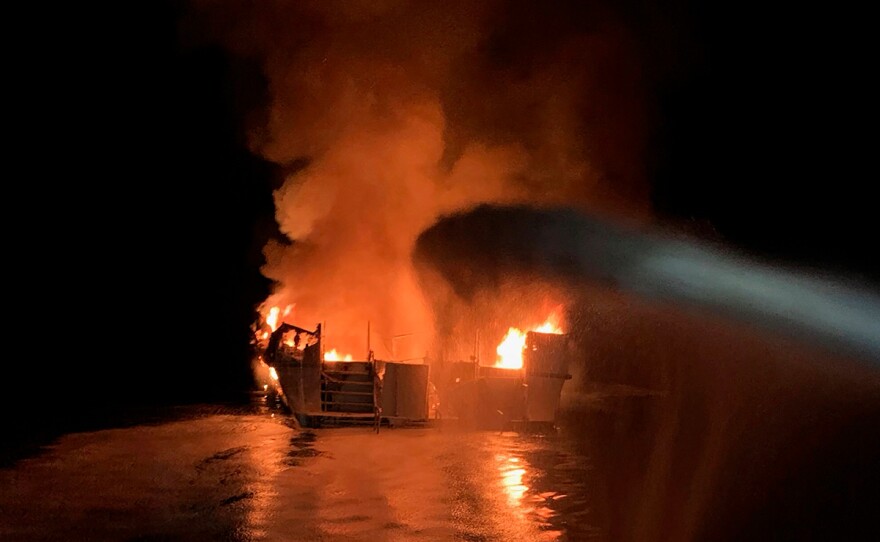Officials have vowed to find what sparked the inferno aboard the dive boat Conception that killed 34 people in waters off Southern California, but vital evidence may have gone down with the ship or drifted out to sea.
The main piece of evidence, the charred remains of the boat, rests on the sea floor in 60 feet (18 meters) of water. Other items that could provide valuable clues could have been carried away by tides or destroyed in the blaze that burned so hot DNA is needed to identify the dead.
"All of that will be a very large hurdle to overcome," said George Zeitler, a former Coast Guard inspector who runs his own marine investigation firm. "It will definitely make for a complex investigation."
Investigators will want to craft a timeline of the ship's final voyage from the moment it pulled away from a Santa Barbara dock early Saturday morning until dispatchers received the frantic mayday call of the breathless captain overwhelmed by smoke, experts said.
RELATED: Coronado Woman Among Confirmed Dead In Channel Islands Boat Fire
They will look at the ship's layout and whether the bunk room below deck was too cramped and had enough exits, review maintenance records and even study photos and videos from people who have been on the boat to look for valuable evidence.
As the investigation into the Labor Day tragedy expands on land and sea, federal and local authorities will look not only at determining what went wrong but also seek lessons that could lead to changes in commercial vessel regulations.
"Our mission here while we're on scene is to determine how this happened, why it happened and what safety improvements are needed to prevent it from ever happening again," said Jennifer Homendy of the National Transportation Safety Board.
The fire, investigated with help from the FBI and Bureau of Alcohol, Tobacco, Firearms and Explosives, is being treated as an accident and there's nothing to suggest anything "nefarious," said Santa Barbara County Sheriff Lt. Erik Raney.
The Conception, owned by Truth Aquatics, had been chartered for three days by a commercial dive outfit based in Santa Cruz to explore the rugged Channel Islands, sometimes referred to as the Galapagos of North America, about 20 miles (32 kilometers) south of Santa Barbara.
The mayday call came at 3:15 a.m. Monday as passengers would have been sleeping while the boat was anchored just off Santa Cruz Island.
While initial details were limited, Santa Barbara County Sheriff Bill Brown said fire above deck blocked the one stairway and an emergency exit hatch where 33 passengers and one crew member were sleeping in their bunks. It's not known if any alarm sounded or what the people below deck may have done to try to escape.
"If an emergency exit is blocked due to fire and prevents one from escaping, it's a horrific situation," said Hendrik Keijer, an investigator with Robson Forensic who has captained cruise ships and operated cargo boats. "Vessels are mazes."
The five survivors were all crew members, including the captain. They apparently jumped from the boat's bow, where the stairway led to the sleeping quarters, and swam to the stern, where they escaped in a dinghy and were taken aboard a nearby boat.
RELATED: Officials: Fire Blocked Escape For 34 Divers Asleep On Boat
Attorney James Mercante, a former merchant marine officer who has defended thousands of maritime casualty cases, said it was unusual that only crew members survived, but that is likely because they were above deck.
Mercante said he would want to find out what the crew did upon being alerted to fight the fire and for how long before they abandoned ship.
"Something was ignited that spread a fire rapidly," Mercante said. "It must have spread awfully quickly if nobody but the crew got out."
Even with limited physical evidence, fire investigators should be able to pinpoint where the fire began, though finding the cause will be more difficult, Mercante said.
The leading causes of boat fires are, specifically, electrical problems and, generally, stupidity, said Walter Godfrey, who has investigated more than 2,000 boat fires in a career spanning a half-century.
By all accounts Godfrey has seen, Truth Aquatics had a good reputation and a clean record of service and was not the type of outfit to employ do-it-yourself electrical wiring.
"I don't think they'd be cutting those kind of corners," Godfrey said. "I would think just off the top of the head this would have to have been something totally accidental and not something ... you would anticipate."
Coast Guard records show fire safety violations on the Conception in 2014 and 2016 were quickly fixed. There were no deficiencies found in February or August 2018 inspections.
The same problems that lead to house fires every day can also sink ships: kitchen fires, unextinguished cigarette butts and gas leaks.
While experts did not want to speculate on a cause, Godfrey said he would want to know more about the built-in barbecue on board and where gasoline was stored for the dinghy. He said electrical fires are most common because a boat — even when docked — is always moving and wires get chafed and exposed. They can arc and spark or ignite gas vapors.
A fire on board can rapidly become a terrifying situation with no help nearby.
"It's very difficult to fight fires without outside help," Keijer said. "You're really on your own in most instances. It's up to the vessel's crew to fight fires. It's not like one can easily escape a vessel. You walk out of a building if a fire occurs on land. That's not as easy on vessels."





